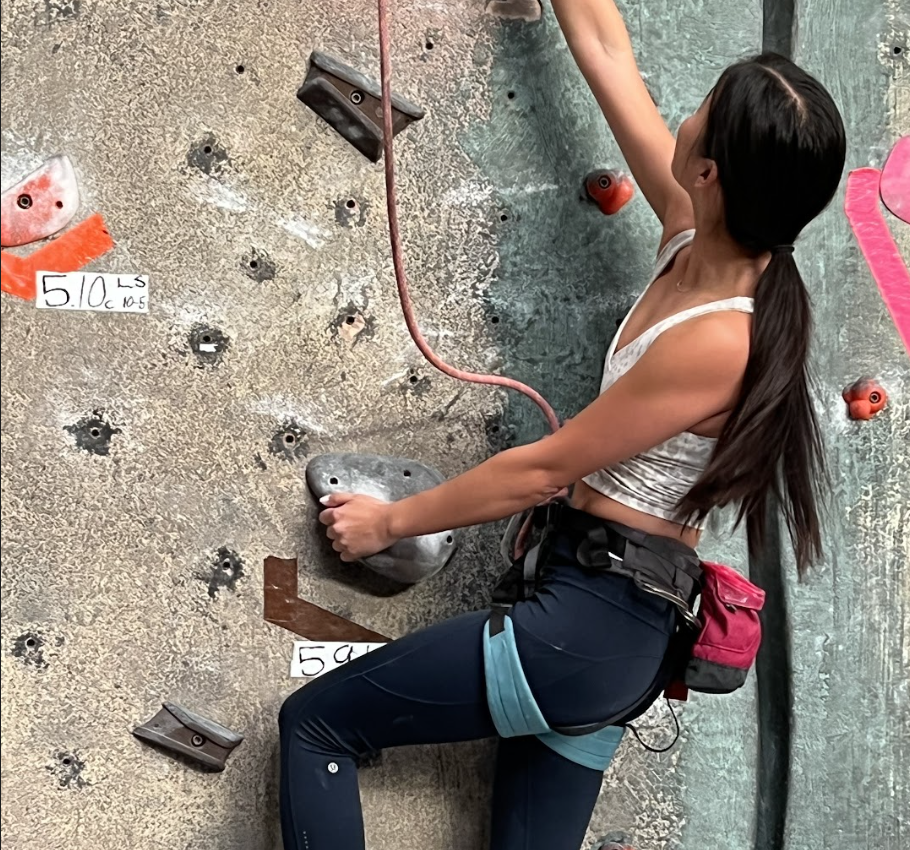After a day of teaching AP Literature and English 12, Emily Wu doesn’t go to the typical Fitness 19 or Planet Fitness centers for a workout. Rather, she takes a 34-minute drive from campus to a Santa Cruz gym called Pacific Edge. There she meets up with her partner and puts on a harness to begin her favorite exercise: indoor rock climbing.
Six years ago, Wu was in search of a new hobby when she stumbled upon a coupon to try Sender One, a rock climbing gym in Orange County where she lived.
“It was like a 10-time climbing pass,” Wu said. “I made a friend from an intro class and then we just went from there and became partners.”
Since then, Wu has been climbing weekly, including when she moved to New Zealand for a year during a leave from teaching in the 2021-2022 school year.
Out of the three main kinds of indoor climbing — bouldering, top-roping and lead climbing — Wu top ropes. Top roping is a form of climbing where the climber is fastened to a rope that is anchored above the course. Lead climbing is different in that lead climbers attach their ropes to different anchors as they climb.
Top roping and lead climbing are safer than bouldering, which has no harness. However, even with a rope, climbing requires acute strength, coordination and technique. The difficulty further increases as climbers move from lower-level courses to higher-level ones.
The difficulty of rock climbing courses are graded on two scales: the Yosemite Decimal System (YDS) and the French. YDS ranges from 5 to 6: 5.2-5.9 is beginner, 5.10-5.11 is intermediate with four subcategories from “a” to “d” for each, and 5.12-5.15 is advanced. Wu is currently working on 5.10b’s and c’s.
As a member of Pacific Edge, Wu goes to work out with her partner once or twice a week. Out of the gyms she’s experimented with, she likes Pacific Edge the most because of the quality of its courses.
A feature of indoor climbing gyms is that they rotate their routes, so Wu often goes back to the gym after a few weeks only to discover that everything has been changed. Wu said this is frustrating because that means if she has a goal to finish a course, she has to complete it within a week before it’s gone forever, leading to unsatisfying results at times.
“One time in New Zealand, my partner and I wanted to try a course that had an overhang,” Wu said. “And we just kept falling and falling and falling. It was so frustrating that both of us couldn’t get it. We left it and then when we came back, it was rerouted.”
Still, Wu said she enjoys the challenge as it pushes her to work harder to complete a course in one go.
After becoming comfortable with top roping, Wu thinks that her next step for indoor climbing will be lead climbing: climbing while being roped to the wall below her instead of an anchor above.
“Someday I want to try lead climbing to challenge myself and not be anchored to something and tie in as I go.” Wu said. “That’s what I enjoy about climbing. I’m constantly climbing to greater heights not only physically but also metaphorically as I continuously challenge myself.”



























